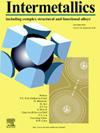实现金属玻璃的可控强度塑性平衡:势能梯度
IF 4.3
2区 材料科学
Q2 CHEMISTRY, PHYSICAL
引用次数: 0
摘要
金属玻璃的强度和塑性问题一直困扰着人们。这限制了这些材料的潜在应用。受梯度材料概念的启发,我们设计了一种利用势能梯度来解决这一挑战的新策略。在这项研究中,我们设计了三种不同类型的mg,每一种都具有可控的阶跃势能梯度。大量的分子动力学模拟表明,以自由体积空间梯度分布为特征的势能梯度mg具有“剪切带偏转”能力。这种自由体积梯度结构促进剪切带的分支和偏转,分散变形,延迟损伤,从而赋予梯度mg额外的塑性。同时,势能梯度mg中高的二十面体含量也有助于其强度。通过改变势能梯度的方向和阶幅,可以调节强度和塑性的同时增强,这表明长期存在的强度和塑性之间的权衡可以通过可控势能梯度来解决。本文章由计算机程序翻译,如有差异,请以英文原文为准。
Achieving controllable strength-plasticity balance in metallic glass: Potential energy gradient
Metallic glasses (MGs) have long been plagued by a dilemma concerning their strength and plasticity. This has restricted the potential applications of these materials. Inspired by the concept of gradient materials, we have devised a novel strategy to address this challenge by leveraging potential energy gradients. In this study, we have designed three distinct types of MGs, each exhibiting controllable step potential energy gradients. Extensive molecular dynamics simulations have demonstrated that potential energy gradient MGs, characterized by a spatial gradient distribution of free volume, possess a "shear band deflection" ability. This free-volume gradient structure promotes the branching and deflection of shear bands, disperses deformation, and delays damage, thereby conferring additional plasticity to the gradient MGs. Concurrently, the high icosahedral content in potential energy gradient MGs contributes to their strength. The simultaneous enhancement of strength and plasticity can be modulated by altering the direction and step amplitude of the potential energy gradient, indicating that the long-standing trade-off between strength and plasticity in MGs can be addressed by controllable potential energy gradients.
求助全文
通过发布文献求助,成功后即可免费获取论文全文。
去求助
来源期刊

Intermetallics
工程技术-材料科学:综合
CiteScore
7.80
自引率
9.10%
发文量
291
审稿时长
37 days
期刊介绍:
This journal is a platform for publishing innovative research and overviews for advancing our understanding of the structure, property, and functionality of complex metallic alloys, including intermetallics, metallic glasses, and high entropy alloys.
The journal reports the science and engineering of metallic materials in the following aspects:
Theories and experiments which address the relationship between property and structure in all length scales.
Physical modeling and numerical simulations which provide a comprehensive understanding of experimental observations.
Stimulated methodologies to characterize the structure and chemistry of materials that correlate the properties.
Technological applications resulting from the understanding of property-structure relationship in materials.
Novel and cutting-edge results warranting rapid communication.
The journal also publishes special issues on selected topics and overviews by invitation only.
 求助内容:
求助内容: 应助结果提醒方式:
应助结果提醒方式:


